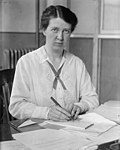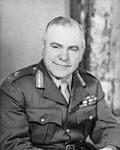From today's featured articleMary van Kleeck (1883–1972) was an American social scientist and social feminist who advocated for scientific management and a planned economy. She began her career in the settlement movement, investigating women's labor in New York City. In 1916 she became the director of the Russell Sage Foundation's Department of Industrial Studies, which she led for over 30 years. During World War I, she was appointed by U.S. president Woodrow Wilson to lead the development of workplace standards for women entering the labor force. After the war, she led the creation of the Women's Bureau, a federal agency that advocates for women in the workforce. By the 1930s, van Kleeck had become a socialist, arguing that central planning of economies was the most effective way to protect labor rights. During the Great Depression, she became a prominent left-wing critic of capitalism and the New Deal. (Full article...)
Recently featured:
Did you know ...
|
In the news
On this day
|
From today's featured list
American actor Chris Evans's filmography has spanned multiple productions since his first screen performance in 1997. After making his acting debut in an educational film co-produced by the National Fish and Wildlife Foundation, Evans acted in several teen comedies, including Not Another Teen Movie and The Perfect Score. He portrayed the superhero Human Torch in the 2005 film Fantastic Four and its 2007 sequel, Fantastic Four: Rise of the Silver Surfer. It would be the first of many roles in films adapted from comic books for Evans; his most prolific role in the genre would be as Steve Rogers (Captain America) in the Marvel Cinematic Universe series of films, where he has made credited appearances and cameos as the character in eleven films and one video game. Though comic book films have formed the bulk of Evans's filmography since the mid-2000s, he has concurrently acted in a range of non-comic book projects, notably Sunshine, Knives Out, and the Broadway revival of Lobby Hero. (Full list...)
Today's featured picture

|
Lenin, a Soviet nuclear-powered icebreaker, was both the world's first nuclear-powered surface ship and the first nuclear-powered civilian vessel. The ship entered operation in 1959 and worked to clear sea routes for cargo ships along Russia's northern coast. Nuclear power proved to be an ideal technology for a vessel working in such a remote area, as it obviated the need for regular replenishment of fuel. From 1960 to 1965, the ship covered over 85,000 mi (137,000 km) during the Arctic navigation season, of which three-quarters was through ice. After being decommissioned in 1989, the vessel was subsequently converted into a museum ship and is now permanently based at Murmansk. Photograph credit: Andrew Shiva
Recently featured:
|
Other areas of Wikipedia
- Community portal – Bulletin board, projects, resources and activities covering a wide range of Wikipedia areas.
- Help desk – Ask questions about using Wikipedia.
- Local embassy – For Wikipedia-related communication in languages other than English.
- Reference desk – Serving as virtual librarians, Wikipedia volunteers tackle your questions on a wide range of subjects.
- Site news – Announcements, updates, articles and press releases on Wikipedia and the Wikimedia Foundation.
- Village pump – For discussions about Wikipedia itself, including areas for technical issues and policies.
Wikipedia's sister projects
Wikipedia is hosted by the Wikimedia Foundation, a non-profit organization that also hosts a range of other projects:
Free media repository
Wiki software development
Wikimedia project coordination
Free textbooks and manuals
Free knowledge base
Free-content news
Collection of quotations
Free-content library
Directory of species
Free learning materials and activities
Free travel guide
Dictionary and thesaurus




